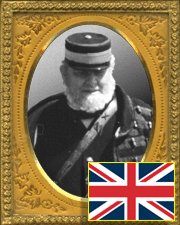
Military Observer's
Journal
 |
A Military Observer's Journal |
|
Military Observer’s Journal
The cylinder is formed of light wheels of tin, the spokes being tubes I inch in diameter. The wheels are kept in their places by a hollow tube 2 inches in diameter, that runs through their centre as an axis from end to end of the pontoon. Disos of tin, the size of each wheel, divide the interior of the pontoons into nine distinct compartments, each perfectly watertight; there is a pump hole to each compartment that is closed by a screw plug. There are also five sets of sunken handles in the length of the cylinder by which the pontoon can be carried by hand, and to which the saddles which receive the superstructure of the bridge are lashed. A stout iron ring is attached to the apex of the hemisphere at each end of the pontoon.
A Single Raft is composed of two pontoons with their superstructure and stores and is carried on one pontoon wagon.
A Raft to support heavy artillery should be formed of three pontoons, or more if necessary, and the gun should be placed on skids, in order to distribute the bearing over the whole raft.
Pontoon Bridges are usually formed by connecting the pontoons with the superstructure in succession from the shore, and booming out until the bridge completely spans the river; or they may be formed by connecting rafts in sufficient numbers to effect that object, the ends of the bridge being carefully connected with the banks of the river.
The Saddle is a framing of wood 12 feet long, I foot 2 inches broad and 3 inches in depth, having six sets of cleats at regulated distances to receive the ends of the baulks, which are pinned to them in forming the bridge, and a double belaying cleat at each end; the saddle is placed lengthwise on the pontoon and is firmly lashed to the sunken handles above referred to.
The Baulks are also of wood, 14 feet 2 inches long, 41/2 inches deep, and 3 inches broad. After they are placed and properly pinned to the saddles, the chesses, which form the flooring of the bridge, are laid upon them.
Whole Chesses are formed of three 1 1/2 inch wood planks nailed to four Cleats on the under side. They are 11 ft. 5 inches long and 2 ft. I inch broad.
Half Chesses consist of a single 1 1/2 inch plank 11 ft. 5 inches in length, I ft. 1/2 inch in breadth, bound with 1 1/4 inch hoop-iron at the ends, and also at 4 ft. 3 inches from each end. The half chesses have no cleats and are placed over the saddles in order to afford ready access to the pins, etc.
© 1999, James Mathews, all rights reserved. Contact Mr Mathews for permision to reproduce.
Return to the main Société d'Europe page
Return to the table of contents for "A Military Observer's
Journal"
Links to web sites related to this topic:
Society Web Page for James Mathews
The Adventures of Ian McKay